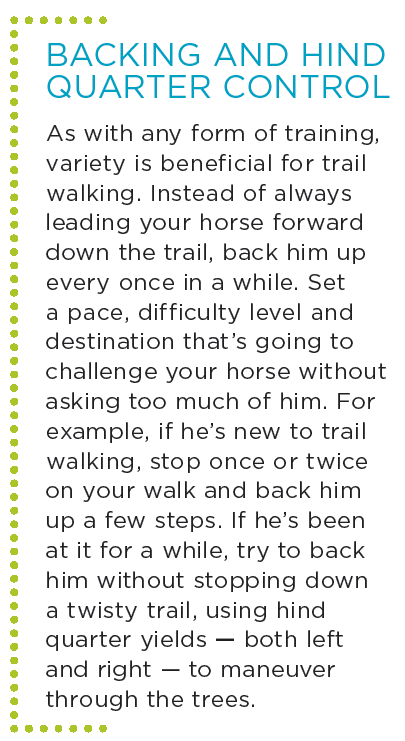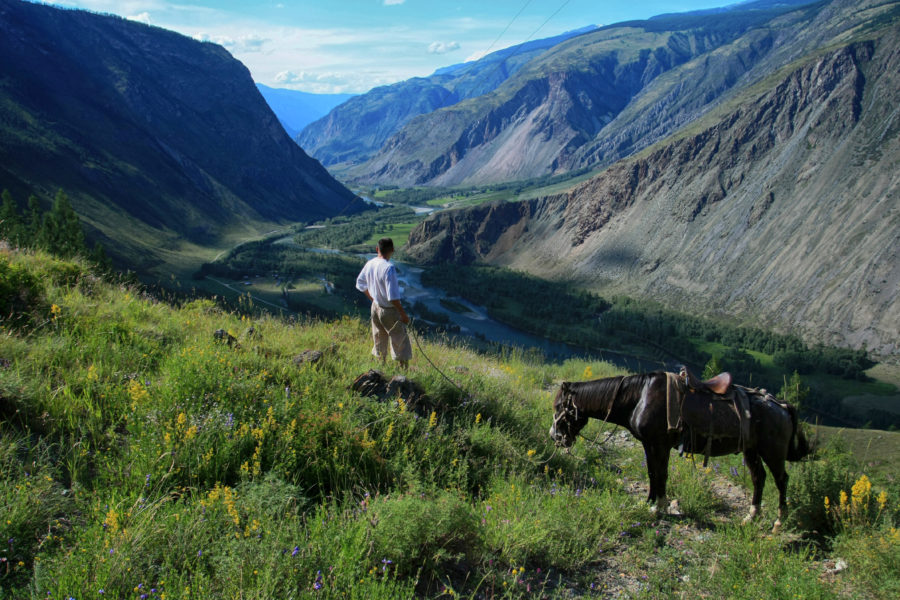Trail walks are an enjoyable way to develop your horse and test some of the skills you’ve been working on in the corral.
Trail walks are just what they sounds like: walking your horse online on a trail. The purpose is to ask him to do things you might want him to do when you’re riding on the trail, and to see what his behavior is going to be like while you’re not on his back. Many people compete in horse shows but can’t actually lead their horses through the trees. Chances are, their performance in the corral would improve if they could practice leading and riding their horses out on the trails.
Goals and benefits
Regular trail walks will help you develop a mentally and emotionally fit horse that can adapt to any situation. A horse that’s mentally fit is able to think through situations, while emotional fitness refers to his ability to use reasoning and problem-solving skills so he doesn’t get emotional. Ideally, you want a horse that will calmly understand and follow your requests even if he’s in an unfamiliar situation. A safe horse is ready, willing and responsive, and always says “yes, ma’am” and “yes, sir”.
The second goal of trail walks is to develop yourself into a calm, rational and responsive handler/rider. Leading your horse on the trail will help you discover your own mental and emotional fitness, and give you a chance to push your limits. Pick something easy to start with – whatever that means for you and your horse. Maybe it means choosing a short trail with only one tree and no hills – however, you must be able to do much more than that as your skills improve. You should be able to go all day long and deal with any number of obstacles. If that’s not possible at this time, don’t fret – just continue working toward your goal.
Before you head out
At our farm, we use what we call “the seven patterns” to help a horse develop some basic ground skills prior to going on trail walks. This method involves seven basic steps that help the handler gain control over the horse’s movements. Here’s a quick breakdown:
1. Build your horse’s confidence
Make sure movement and noise don’t bother your horse by using sticks, strings, flags and other items. You should be able to rub these items all over your horse, and wave them around, without frightening him.
2. Apply steady pressure
Touch your horse using different phases of pressure to back him up, and ask him to perform hind quarter and four quarter yields turning on the correct foot.
3. Apply rhythmic pressure
This is similar to step two, but you’re using rhythm to ask your horse to back up and perform yields.
4. Ask your horse to do simple tasks while you stand
Back him up and bring him forward using your lead line while you stand still.
5. Lunge your horse
Without bothering him, ask your horse to move in a circle while you stand still. Being able to send your horse somewhere without chasing him (i.e. encouraging him with a lunge whip or stick) is an important step in his training.
6. Ask him to move sideways
Have him go sideways along a fence line at the end of his lead line, in both directions.
7. Send him out
Without moving your feet, ask him to walk to the end of his 12’ lead, then have him turn and face you.
These are very basic skills, but should be accomplished before heading out on the trail. Of course, the better you are at groundwork, the easier trail walking – and other activities – will be.
 During trail walks – things to keep in mind
During trail walks – things to keep in mind
Congratulations – you and your horse are ready to go on your first trail walk. Now the real work begins! The first thing to consider is the pace you’ll be walking at. Pace is something you should ideally be teaching your horse during groundwork exercises in the corral – if you haven’t been, it will be quite evident on the trail. Ask your horse to walk up and down hills at your speed, not his. He should also stop on both flat and elevated terrain if asked, and back up and down hills (see sidebar at right). Try varying your pace, and have him follow on a loose line.
Just as you set the pace, it’s also up to you to choose the distance you want your horse to be from you. It should be further than you think. If you’re hanging onto the clip on the bottom of his halter, that’s way too close for both of you. You should be at least a full arm’s length away from him, but even further is better.
Working with obstacles
Once your horse is familiar with the basics of trail walking, you can start introducing some obstacles. This will add more depth to your abilities and your horse’s, making your trail walk easier, not harder.
- Use ditches and fallen trees to jump your horse online. Do this by standing still and sending your horse over the obstacle. Develop your send to the point where you have multiple speeds and distances you can ask of your horse.
- If you can find puddles, creeks and shallow mud holes, ask your horse to calmly walk through them.
- A row of trees provides a great opportunity for you to practice weaving with your horse. He’ll learn to move thoughtfully and pay attention to your subtle direction without bumping into you.
Exposing your horse to the different landscapes that trails have to offer will help him become more relaxed and thoughtful in all aspects of your training. A trail walk is also a great way to spend an afternoon with your horse and develop the bond you share. Happy trail walking!







